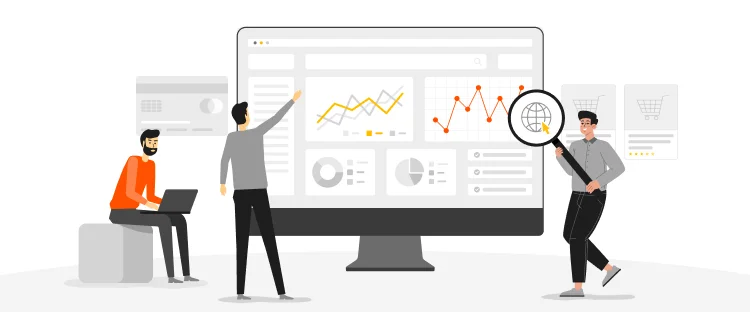For global brands, the internet is a magical world of endless possibilities and boundless opportunities. It's all about convenience, there is no need to even leave your house to run your full-fledged product or services business. You can literally reach out to global customers and explore the international market - that too cost-effectively. Today, more than anything else, brands are focusing on staying relevant to their customers.
Taking the customers comes the first approach, brands try to build strong identities internationally that could create influence. When it comes to relevancy, brands build multilingual identities to connect with their audiences on a deeper level. Not just that, developing a strong multilingual brand strategy would also break the language barrier and give your brand a global presence. You have to create a powerful multilingual market strategy based on your audiences, market, and business goals. This article provides guidelines to manage your multilingual brand presence.
Most businesses still do the conventional way of marketing and don’t focus on multilingual branding. They are missing out on something really big for sure. A multilingual presence thrives your brand in foreign markets, and you can scale your business more smoothly. A multilingual brand is more likely to grasp the attention of audiences because it can resonate with their interests and presences.
Studies have also proven that there are more chances customers would buy from the brands that speak their native languages. People are more likely to trust brands that look local. Multilingual marketing allows you to attract more local audiences by adapting all elements of your brand to the local preferences. You have to direct your marketing efforts considering the community norms and social influences. It would help your brand easily fit into the local culture. Multilingual marketing not just improves your communication with audiences but also helps you maximize revenue.
You have to be very careful while designing your multilingual marketing strategy because a tiny mistake can be devastating for your brand’s global image. Following are some of the best practice guidelines to develop a multilingual brand personality.
It all starts with your market research. Your business can have a global potential but it does not mean you have to try every single marketplace. Not every market is your target market, not everyone is your customer. It is significant for you to research your market, and launch your products or service in the markets with full potential. Otherwise, you will be only wasting your time and efforts. Define your niche and know your audiences to focus your marketing efforts in the right direction.
You can conduct an online survey asking people about your brand, what they think about it, and whether or not they would buy it. It would help you get an idea about the audience preferences; you can make informed decisions about your business expansion. You can also test your product on a sample of customers before officially launching it to that market.
Once you have found the potential markets for your brand launch, it's time to design your multilingual marketing strategy. You should have your business goals well-defined to create a strategy aligned with these goals. In this stage, you have to make a list of all the tools of resources that you would need to fulfill your multilingual branding plan. You might need a marketing and localization expert to help you down the line with the development and execution of a multilingual strategy. You have to make a complete multilingual content plan for social media and other platforms.
When it comes to creating a multilingual brand presence, website localization has the most significance. Your website is the online representation of your businesses, so you must design and localize it to provide the best online experience to your customers. In the localization process, you have to adapt your website appearance and content to the cultural and social preferences of customers. From the display of time and date to the payment methods, everything will be modified to the standard of that country.
For instance, some countries follow a 12-hour clock, and others follow a 24-hour clock. So based on the local standard of countries you have to change the formatting accordingly. For the website localization purpose, all the translators, designers, and developers have to come together and work collaboratively on the site to make sure that everything is going well.
When it comes to website localization and marketing ad designing, content translation into the native language of target customers is crucial. You need to hire professional translators and editors for translating the content of your website into different languages. Most brands do content transcreation into different languages. Transcreation goes one step ahead of conventional translation, as it doesn’t just focus on translations but the translator maintains the context and more message of the content.
He makes sure that the content is befitting the cultural background of the targeted region, as well as it is triggering the right emotions in customers. Your website content translations have to be creative, culturally appropriate, and linguistically correct.
Whether it is your website or social media posts, your content is not just textual. There are also some visual elements that make your content more engaging for the customers. Just like the textual content, you must localize your visual content as well. You can provide subtitles and dubbings in different languages for your visual content. Moreover, it might not always be enough.
In some cases, you may have to transform the video and audio content to make it more relevant to audiences. It is possible that a video you are going to put on social media is normal for one region, and for others it is offensive. In such cases, you need to change the video content and adapt it in a way that is accepted in your target region's culture. In the end, the idea is to create relevance by transforming all textual and visual content elements.
Your translated content should be culturally appropriate. You must hire someone who is culturally aware and understand the cultural sensitivities of the targeted group. Especially, if you want to run a marketing campaign or an ad in a foreign country, you must be careful enough to not offend people. Things that are normal in one culture could be offensive and insensitive to other regions.
For instance, if you want to run an ad for your middle eastern audience, understanding their cultural norms, you should be careful while depicting a female in the ad. Women dress a certain way in middle eastern countries. So, portraying girls in western clothes in your ads would be offensive.
It would not just hurt the sentiments of people but legal action might be taken against your brand by authorities. So, it’s all about knowing your audiences, understanding their emotions, and branding your products to create a resonance with the cultural elements.
How you advertise your brand in a foreign market has a huge influence on your audiences and it also shapes the way people think about your brand. Creating localized multilingual ads would make it much easier for you to grab the attention of more people. It would give you a competitive edge and cause a significant increase in your internet users. Moreover, multilingual ads are cost-effective because it gives you more value for a relatively lesser amount you would spend on PPC ads.
Multilingual ads are not just about swapping the words from one language to another. It is more to do with the context, culture, and core message of your ad. Along with changing the language, you have to make sure that all elements you are portraying in the ads are emotionally aligned with the psychology of your targeted customers.
When it comes to localization or creating a multilingual brand identity, using a professional TMS tool would be a savior. These tools not just help you with effective translation management but also save a lot of money and effort. Less time is spent on manual file handling and maximum work is managed by systems without any human intervention. Moreover, TMS tools enhance your overall translation management speed by optimizing the workflows and streamlining the everyday translation operations.
Based on your brand goals, you can choose your TMS software accordingly. Different TMS tools offer diversified features, so you must carefully select the one that would fulfill your brand’s needs. You can also customize your TMS to the unique brand needs of a reliable service provider.
There are two ways you can build a multilingual brand identity: do it yourself, or hire a professional to do it for you. If you want to focus on your business, hiring a third-party LSP would relieve your burden so you can concentrate on your actual business. Based on your multilingual branding and translation requirement, you have to pay a lump sum amount to your LSP every month.
Payment duration and method may vary based on the contract you have made with your service provider. It is very important to hire someone with extensive industry experience and a good reputation in the market. Because the company you would hire will be managing your overall multilingual brand identity in a foreign marketplace.
Google search engine results may vary based on the geographical location of your customers. So, even if your website is ranking on top of the search engine pages for your location doesn’t necessarily mean that it would rank high for all locations. It happens because search queries people enter in Google when they are looking for a product are highly influenced by the languages they speak.
You have to do SEO for the different regions you are targeting to make sure that your website is visible to targeted audiences. You have to do a multilingual keyword optimization for every region based on the phrases people are most used to using when they are looking for brands like you. So, to develop a multilingual brand, you must create a multilingual SEO strategy to drag more traffic to your website.
Maintaining a multilingual brand presence could be challenging, especially if you don’t have any experience or knowledge in this domain. Here are a few most common mistakes that you must avoid while doing multilingual branding.
Your overall brand reputation in the foreign market depends on the quality of translations. Using unreliable resources or free machine translation tools is a big no. Many famous companies have been through this situation when they mistranslated their brand message in a foreign market. It could even damage your overall brand persona and badly offend the audience. So, make sure you are getting your content translated from reliable resources, instead of using free tools.
Most brands think that a bilingual person is a perfect candidate for translating the content from one language to another. It is a misconception because just because someone is bilingual doesn’t make them an ideal choice for translation. You must hire a certified translator who has fair experience working in the field.
Professional translators have extensive linguistic knowledge, and they also understand the cultural impact on languages in different regions, which makes them a good choice for translations.
For every region, you have to consider the cultural sensitivities and social norms while doing translations. You must develop empathy towards the cultural norms and values of targeted customers. It would allow you to connect with your audience and build a lasting relationship with them. Moreover, you must make sure that the translations stick to the core message of the brand and that there are no contextual or logical errors in the content. Once the translations are completed, you must check the text for grammatical, logical, cultural, and linguistic mistakes.
This article is an overview of all the steps you must take to build a robust multilingual brand strategy. Building a strong multilingual brand identity would enhance your brand’s credibility in the foreign marketplace. It would also allow you to have a smooth brand entry into a new marketplace. You should avoid the mistakes mentioned in this article. Moreover, before working on your multilingual brand strategy, you must have gathered all the tools and resources that you may need for the successful accomplishment of your multilingual brand goals.

Many global companies, foreign governments and Iranian are hoping to see an increase in investment in Iran after declaring the
Read More
Artificial intelligence has taken a big space in almost every industry. There is also a widespread acceptance that AI is
Read More
Persuasion is all about manipulating other people behavior. At first it might sound immoral but it doesn’t have to be.
Read More
Now days everyone is searching for good ideas for their company they wanted to be more creative, they wanted to
Read More
Technology has now much diverse roots in this age of development. Now it is not wrong to say, that you
Read More
Localization is the practice of altering the functional properties of a product and also its characteristics. This is easily done
Read More
It is very important to know the fast and fearless front-facing trends of marketing your business in the digital age.
Read More
Nigerian Customer Purchasing Trends – All You Need To Know To Increase Your Sales! Online shopping is one of he many
Read More
Online Customer Purchasing Trends – Why the Polish Market Is Good For Your Sales? The Polish consumers are one of the
Read More


Document Translation
Professional document translation by native expertsApp Localization
Get more downloads by adapting your app for different target marketsVideo Translation
Multilingual translation and subtitling servicesWebsite Localization
Adapt your website into multiple contexts for global reachSoftware Localization
Adapt your software for global usersGame Localization
Reach new players with localized gameplayMTPE
Refine AI translations for natural fluencyBusiness Translation
Professional translation for business documents and websitesDTP & File Conversion
Professional DTP and File conversion, supporting multiple file formatsProofreading
Perfect your content with expert review© Copyright 2025 MarsTranslation